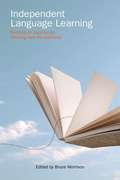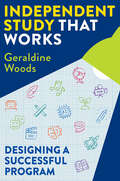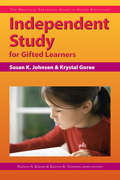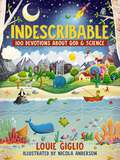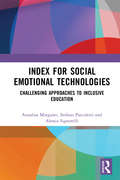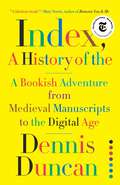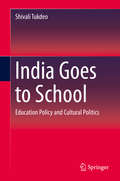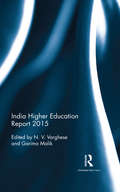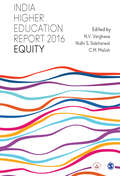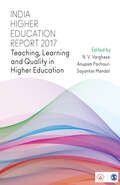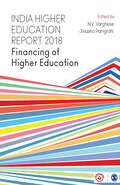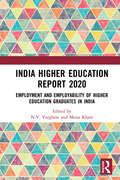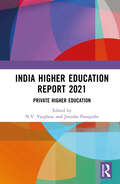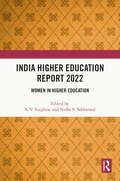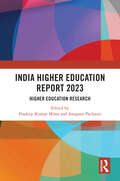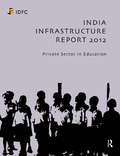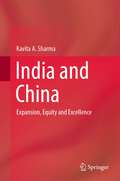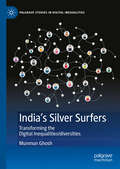- Table View
- List View
Independent Language Learning
by Bruce MorrisonIndependent learning is not a new concept for language educators but while teachers, curriculum designers and policy makers have embraced it as underpinning modern notions of education, it remains a dynamic and vibrant field for researchers and academics who aim to broaden its scope and deepen our understanding of how it may be applied most effectively both inside and outside the classroom. The book's authors use their experience of applying the concepts related to independent learning in various geographical, cultural and pedagogical tertiary level learning contexts to present new perspectives on how independent learning can inform and support policy, teaching methodology, curriculum development and the nurturing of successful learners. While the first section of the book provides a view of the field from three broad curriculum development viewpoints, the remaining chapters primarily focus on the experience of learners, teachers and curriculum developers in applying principles of learner autonomy, self-regulation and self-direction with various types of learner - each with their own identities, motivations, expectations and goals. These learner and teacher stories provide insights that are important for an understanding of some of the impacts an independent learning approach to language learning have on learners in various educational contexts. This book will be of value to pre-service and in-service teachers, curriculum developers and teacher educators working in diverse educational contexts in more fully appreciating the contribution an independent learning focus can make to successful learning.
Independent Living: A Curriculum With Adaptations for Students With Visual Impairments, Vol. 3
by Nancy Levack Robin Loumiet Brigitte MaGeeIndependent Living Volume III: Play and Leisure 2nd Edition Texas School for the Blind and Visually Impaired
Independent Living: Assessment & Ongoing Evaluation for Independent Living
by Texas School for the Blind and Visually ImpairedAssessment & Ongoing Evaluation for Independent Living <P><P> A Curriculum with Adaptations for Students with Visual Impairments
Independent Study That Works: Designing a Successful Program
by Geraldine WoodsIndependent study programs aren’t for the “best” students; they are populated by students at their best. Student disengagement from school is a trending concern, and many schools have turned their attention to independent study programs as a way to nurture student motivation and creativity. But where to begin? Geraldine Woods offers a practical, step-by-step guide based on her experience designing and directing the much-admired independent study program at the Horace Mann School. Under the supervision of teachers, students embark on a remarkable variety of projects and become teachers themselves, conducting seminars with their peers along the way to preparing their final product—which could as easily be an interactive website or musical composition as a research paper. Woods’ book details the nuts and bolts of the approach and shows how to customize it for a variety of age groups, budgets, and curricular requirements. It is a gift to all educators—including homeschooling parents—who want to give students the freedom to pursue their interests.
Independent Study for Gifted Learners
by Susan K. Johnsen Krystal GoreeIndependent study is one of the most frequently recommended instructional strategies for differentiating and individualizing instruction for gifted students. When compared to learning styles of more average students, gifted students like instructional strategies that emphasize independence such as in-depth study and discussion. Allow your gifted students to study a high-interest topic with depth and complexity. This book offers the advice you need to help your gifted students explore important content and show their learning in creative and innovative ways. From selecting a topic, to using innovative research strategies, to reporting results in an interesting way, this book shows you how to help your students succeed at independent study. This is one of the books in Prufrock Press' popular Practical Strategies Series in Gifted Education. This series offers a unique collection of tightly focused books that provide a concise, practical introduction to important topics concerning the education of gifted children. The guides offer a perfect beginner's introduction to key information about gifted and talented education.
Indescribable: 100 Devotions for Kids About God and Science (Indescribable Kids)
by Louie GiglioDiscover the Wonders of the Universe with the CreatorIt’s impossible to out-imagine God. He orchestrates time, creates light, and speaks things into existence—from the largest stars to the smallest starfish. God is a powerful, purposeful, personal, unparalleled Creator.Psalm 19:1 says, “The heavens tell the glory of God. And the skies announce what his hands have made.”Indescribable displays the majesty of creation with scientific findings, photography, and original illustrations. These 100 devotions encourage awe at God’s creativity with an in-depth look at • Space, Galaxies, Planets, and Stars• Earth, Geology, Oceans, and Weather• Animals—from Hummingbirds to Dinosaurs• Our Minds, Bodies, and Imaginations Each devotion features a “Be Amazed” section with fascinating facts, hands-on activities, and a closing prayer. Based on Louie Giglio’s popular messages “Indescribable” and “How Great Is Our God,” Indescribable: 100 Devotions About God & Science will help kids discover the incredible creation of our indescribable God.
Index for Social Emotional Technologies: Challenging Approaches to Inclusive Education
by Annalisa Morganti Stefano Pascoletti Alessia SignorelliIndex for Social Emotional Technologies explores how technology can strengthen access and foster the acquisition of transversal skills useful for inclusive educational processes. It investigates the value that technology can offer to social and emotional learning through different tiers of actions and the main features of educational technology that can support such use. The book brings together educational technologies and research evidence relevant to different education systems to outline new, unexplored ways of intersecting educational and technological fields. It also addresses the need for a guide to designing and creating new inclusive educational tools for an international market. Index for Social Emotional Technologies will be of great interest to academics, researchers, and postgraduate students in the fields of inclusive education, educational technology, and social and emotional learning.
Index, A History of the: A Bookish Adventure from Medieval Manuscripts to the Digital Age
by Dennis DuncanA New York Times Editors' Choice Book and a New Yorker Best Book of 2022 So Far Named a Most Anticipated Book of 2022 by Literary Hub and Goodreads A playful history of the humble index and its outsized effect on our reading lives. Most of us give little thought to the back of the book—it’s just where you go to look things up. But as Dennis Duncan reveals in this delightful and witty history, hiding in plain sight is an unlikely realm of ambition and obsession, sparring and politicking, pleasure and play. In the pages of the index, we might find Butchers, to be avoided, or Cows that sh-te Fire, or even catch Calvin in his chamber with a Nonne. Here, for the first time, is the secret world of the index: an unsung but extraordinary everyday tool, with an illustrious but little-known past. Charting its curious path from the monasteries and universities of thirteenth-century Europe to Silicon Valley in the twenty-first, Duncan uncovers how it has saved heretics from the stake, kept politicians from high office, and made us all into the readers we are today. We follow it through German print shops and Enlightenment coffee houses, novelists’ living rooms and university laboratories, encountering emperors and popes, philosophers and prime ministers, poets, librarians and—of course—indexers along the way. Revealing its vast role in our evolving literary and intellectual culture, Duncan shows that, for all our anxieties about the Age of Search, we are all index-rakers at heart—and we have been for eight hundred years.
India Goes to School: Education Policy and Cultural Politics
by Shivali TukdeoThis book pays attention to education in India as part of several overlapping stories developed along different axes: stories of dissent, contestations, appropriation and social action. . It historicizes the enterprise of formal education by paying attention to the numerous policy shifts. Further, it theorizes the education policy discourse by analysing the ways in which education is increasingly being shaped by international/transnational knowledge production, actors and norms. Focusing on the cultural politics of education policy production, circulation and translation across different contexts, the book revisits some of the long-standing and unresolved debates on social reforms, justice, nationalism and mobility. Evolution of ideas such as mass education, national education, adult literacy and education through public-private-partnerships showcase the momentous shifts in education policy over the course of last century. Ideas, institutional and economic arrangements, administrative formulations and frameworks for implementation make frequent appearances in the cultural as well as political reading of education policy. In a departure from the traditional policy research, this work sees policy as socially and culturally constructed; connected to questions of power, context and struggle; and part of a number of processes at large.
India Higher Education Report 2015
by N. V. Varghese Garima MalikThe unprecedented expansion of higher education in India and the proliferation of providers in turn have posed enormous challenges to equity, quality and financing of the sector. The India Higher Education Report 2015 traces the evolution of higher education and discusses the key role of committees and commissions whose reports and recommendations form the backdrop of contemporary developments. Authoritative and comprehensive, the volume examines a range of themes including equity, financing, employment, quality, and governance. It also engages with new and recent data as well as current issues and debates. The volume will be an important resource for academics, policy makers, civil society organisations, media and those concerned with higher education. It will also be useful to scholars and researchers of public policy, sociology and economics.
India Higher Education Report 2016: Equity (India Higher Education Report)
by N. V. Varghese Nidhi S. Sabharwal C. M. MalishEquity in education is well recognized as central to achieving inclusive growth and development. The second in the series initiated by the Centre for Policy Research in Higher Education of the National University of Educational Planning and Administration, India Higher Education Report 2016 focuses on the theme of equity in higher education. The report examines issues related to the expansion of higher education; economic, social, regional and gender inequalities and their implications on education; student diversity and discrimination; and the changing roles of the state, market and private sector in a period of massification of the education sector. The book also addresses topics on learning outcomes, and employment and employability of higher education graduates. The discussions in the book centre on the theoretical perspectives and empirical evidences. This book will be an important resource for academics, policy makers, civil society organizations, media and those concerned with higher education and development. It will also be useful to scholars and researchers of education, public policy, sociology and economics.
India Higher Education Report 2017: Teaching, Learning and Quality in Higher Education (India Higher Education Report)
by N. V. Varghese Sayantan Mandal Anupam PachauriUnderstanding teaching, learning and quality in higher education requires in-depth engagement with theoretical discourse and empirical evidences. With this objective, the Centre for Policy Research in Higher Education (CPRHE) has initiated multiple research activities to develop deeper insights into quality concerns in higher education. India Higher Education Report 2017 evaluates the Indian higher education system in terms of teaching, learning and quality and presents a comprehensive analysis of reforms that took place in these domains. Organized into three major parts—ranking, research and quality; teachers and teaching–learning; and quality management—this book discusses changes and issues that have affected the country’s higher education system in recent times. This seminal work is a must-have for scholars and researchers of education, social science and public policy.
India Higher Education Report 2018: Financing of Higher Education (India Higher Education Report)
by N. V. Varghese Jinusha PanigrahiIn the last few decades, India has experienced several shifts in the policies pertaining to the financing of higher education. These shifts include a move from public financing to keep pace with the expansion requirements of the sector; the strengthening of market forces in higher education both through privatisation of public institutions and operation of private institutions; and a move from the financing of institutions to the financing of students. The Centre for Policy Research in Higher Education (CPRHE) has initiated major research activities to understand how the recent changes have affected the financing of higher education in India and how the higher education institutions cope with and respond to these changes. India Higher Education Report 2018, the fourth volume in the series, presents this study to provide a comprehensive analysis of financing of higher education in India. This book investigates the changing dynamics and related key issues including state–market dynamics, university–industry linkages, foreign aid, institutional strategies to overcome shortages in funding, issues with self-financing courses, educational loans and fee reimbursement schemes, expansion and financing of private higher education.
India Higher Education Report 2020: Employment and Employability of Higher Education Graduates in India
by N. V. Varghese Mona KhareIndia Higher Education Report 2020 critically analyzes the role played by the state, industries, and higher education institutions in the employment and employability of educated youth in India. The book discusses a wide range of topics such as employability skill gaps of higher education graduates; curriculum and skills training systems; formal and informal modes of skill formation; crisis of jobless growth in India; migration, education and employment; dimensions of gender, caste and education; general, technical and professional education; vocationalization; qualifications framework and skills certifications; curriculum and pedagogy in higher education for skill development; industry–academia linkages; entrepreneurship education and executive education; and sustainable employment. The book focuses on theoretical insights, empirical evidences and recent data on key issues and challenges of higher education graduate employment in a knowledge economy driven by the unprecedented expansion of higher education and increasing digitization. It offers successful cases of institutional responses, examples of policy and practices as also perspectives of different stakeholders such as employers, employees, teachers and students to present trends in the changing landscape of higher education and future demands of the job market for the youth workforce across sectors, subject disciplines and gender. This volume will be an important resource for scholars, teachers and researchers of higher education, public policy, political economy, political science, labour studies, economics, education, sociology in general as well as for policymakers, professional organizations and associations, civil society organizations, and government bodies.
India Higher Education Report 2021: Private Higher Education
by N. V. Varghese Jinusha PanigrahiThis volume provides an in-depth analysis of the critical dimensions of higher education in India. It focuses on the growth and expansion of private higher education and public policy. The volume discusses issues related to the growth of for-profit and not-for-profit private higher education institutions and their implications at the policy level. It outlines the role of such institutions towards the internationalization and global ranking of the Indian higher education system. The book discusses the trends in internationalisation adopted by private higher education institutions and explains the resulting impact on aspects such as the diversity of programs, skill formation, employability, pedagogic practices, standards, curriculum development, and research and development, as well as the wider externalities in terms of promoting India’s soft power and international relations with other countries. While outlining the challenges of Open Distance Learning (ODL) and online education in India, the book also discusses the use of ICT, OER, and MOOCS among others to address the challenges of the ODL system. This volume will be of interest to teachers, students, and researchers of education, public policy, political science, international relations, law, sociology, economics, and political economy. It will also be useful for academicians, policymakers, and anyone interested in the internationalization of Indian Higher Education.
India Higher Education Report 2022: Women in Higher Education
by N. V. Varghese Nidhi S. SabharwalThis book studies the various dimensions of gender inequality that persist in higher education and employment in India. It presents an in-depth analysis of the complex challenges women face in higher education participation and translating higher education opportunities into labour market success and to leadership positions, including in academia. It argues that despite a substantial progress towards gender equality in enrolment, these inequalities pose as barriers in realising the transformative role that higher education can have for women’s wellbeing and for the nation’s development. The volume looks at the issues that keep women from accessing the areas of their choice, and the challenges they face in leadership positions in higher education. An important critique of higher education policy and planning, the volume will be of interest to teachers, students, and researchers of education, public policy, political science and international relations, economics, feminism, women’s studies, gender studies, law, and sociology. It will also be useful for academicians, policymakers, and anyone interested in the study of gender in Indian Higher Education.
India Higher Education Report 2023: Higher Education Research
by Pradeep Kumar Misra and Anupam PachauriThis book traces the contours of higher education research in India. It analyses the Indian higher education system that has seen unprecedented expansion in the last couple of decades with increasing institutional and programme diversification, diverse participants accessing higher education, and curricula becoming more market oriented in a globalised context.The book provides an empirical analysis of issues related to higher education research in the country including international collaboration; analysis of institutions and research programs; and state- and national-level policies determining higher education and research trajectories. It explores the extent to which sources and supplies of funding impact research agenda, research questions, and outcomes. The book conceptually engages with the role of higher education research in providing a direction for policymakers and paving the way towards quality higher education.An important critique of higher education policy and planning, this book will be valuable for researchers and scholars in the field of education, public policy, political science, international relations, law, sociology, economics, and political economy. It will also be of interest to policy makers working in higher education and research.
India Infrastructure Report 2012: Private Sector in Education
by Idfc FoundationToday, India’s education sector remains a victim of poor policies, restrictive regulations and orthodoxy. Despite being enrolled in schools, children are not learning adequately. Increasingly, parents are seeking alternatives through private inputs in school and tuition. Students are dropping out from secondary school in spite of high financial returns of secondary education, and those who do complete it have inferior conceptual knowledge. Higher education is over-regulated and under-governed, keeping away serious private providers and reputed global institutes. Graduates from high schools, colleges and universities are not readily employable, and few are willing to pay for skill development. Ironically, the Right to Education Act, if strictly enforced, will result in closure of thousands of non-state schools, and millions of poor children will be left without access to education. Eleventh in the series, India Infrastructure Report 2012 discusses challenges in the education sector — elementary, secondary, higher, and vocational — and explores strategies for constructive change and opportunities for the private sector. It suggests that immediate steps are required to reform the sector to reap the benefits from India’s ‘demographic dividend’ due to a rise in the working age population. Result of a collective effort led by the IDFC Foundation, this Report brings together a range of perspectives from academics, researchers and practitioners committed to enhancing educational practices. It will be an invaluable resource for policymakers, researchers and corporates.
India and China: Expansion, Equity and Excellence
by Kavita A. SharmaThis book provides a comprehensive overview of higher education in India and China and the complexity of issues involved. It focuses on gaining understanding of education systems, governance mechanisms, globalisation and emergence of the private sector, action policies of both the countries and their impact on education and society. Offering a comparative perspective, the book discusses why China is ahead of India in Higher Education when both share the similar challenges of burgeoning young population and scarcity of resources. It examines the success in providing equitable access to both country’s marginalised sections. It also discusses the directions of future growth through National Education Policy, 2020 and the 13th Five Year Plan of the Chinese State Council. Combining rich content and a broad scope, the book offers a valuable key to understanding Higher Education system of India and China. It is a useful read for students and researchers in social sciences, education area.
India and the Islamic Heartlands
by Sood Gagan D. S."Based on the chance survival of a remarkable cache of documents, India and the Islamic Heartlands recaptures a vanished and forgotten world from the eighteenth century spanning much of today's Middle East and South Asia. Gagan Sood focuses on ordinary people--traders, pilgrims, bankers, clerics, brokers, scribes, among others--who were engaged in activities marked by large distances and long silences. By elucidating their everyday lives in a range of settings, from the family household to the polity at large, Sood pieces together the connective tissue of a world that lay beyond the sovereign purview. Recapturing this obscured and neglected world helps us better understand the region during a pivotal moment in its history, and offers new answers to old questions concerning early modern Eurasia and its transition to colonialism"--
India's Silver Surfers: Transforming the Digital Inequalities/diversities (Palgrave Studies in Digital Inequalities)
by Munmun GhoshThis book provides a thorough investigation of the potential and challenges of older individuals' digital disparities in the context of the digital era. A particular set of challenges prevent the ageing population from efficiently accessing and utilising digital resources as technology becomes more pervasive in contemporary culture. The multidimensional nature of digital disparities is clarified in this work. It explores how these discrepancies affect older people's quality of life, access to healthcare, social connections, and general well-being, taking India as a case study. The book begins by thoroughly summarising demographic trends and changes in technology adoption caused by ageing. It looks at the variables that affect older individuals' propensity to use technology and the effects of their attitudes and perceptions about digital technologies around them. The author investigates the intricate web of access inequities older persons face in a quickly changing digital environment, from internet accessibility to the availability of appropriate digital content. The book also emphasises the need for digital literacy and skills to boost elders' technology involvement. It looks at their challenges when learning and using digital skills, especially in light of how quickly technology develops. The author also explores the effects of digital disparities on older people's physical and mental health, highlighting the demand for specialised therapies and support networks.
Indian Administration M.A. Previous Public Administration Paper-III,SDE AU
by Prof. P. W. Purushotham B. V. V. BalakrishnaThis is the prescribed textbook to the students of MA Previous Public Administration Paper-3 for the subject Indian Administration, at School of Distance education, Andhra University
Indian Constitution at Work class 11 - NCERT
by National Council Of Educational Research TrainingThis is a Political Science textbook for class 11th published by Ncert. Looking at the title of this book, you may wonder: “why am I studying Indian Constitution again? Didn’t I study it in the previous classes?” Yes, you have studied the broad structure of the Indian government and some bits of the Constitution. But this book takes you to something different from what you have already studied. You have now chosen Political Science and will study this subject for the next two years. What better way can there be to get introduced to Political Science than through politics of our own country? That is what this book does. The study of the working of the Indian Constitution here is a gateway to studying politics in India. The study of Indian politics is a window to understanding politics in other societies. We hope that through the study of institutions and the politics of power surrounding them, you would come to know about the principles and theories of politics. Thus this book will tell you about the way our Constitution has been working and the way it shapes politics in our country. This book is not about legal provisions and technical details in the Constitution. It is about how institutions are shaped through interaction with actual politics.
Indian Economy - 1 and 2 First Semester FYBA New NEP Syllabus - SPPU
by Dr Sunil Ugale Dr Amol Gaikwad Dr Manisha AherThe book Indian Economy - 1 & 2 is a comprehensive guide tailored for F.Y.B.A. students under the NEP 2024 syllabus. Authored by Dr. Sunil Ugale, Dr. Amol Gaikwad, and Dr. Manisha Aher, it provides an in-depth exploration of India's economic framework. The text covers foundational topics such as the meaning and classification of economies, indicators of development, and the structure of India's economy, emphasizing its developing status. It delves into the role of agriculture, industry, and services in economic growth, highlighting sectoral contributions to GDP and employment. Additionally, practical insights on India's demographic profile and the interplay of population as human capital underscore the book's focus on economic development challenges, such as poverty, inequality, and infrastructure deficits. The accessible language and adherence to academic requirements make it an essential resource for students and competitive exam aspirants.
Indian Economy - 2nd Edition - Competitive Exam: A complete guide on the concepts of Indian Economy for UPSC, CSE and State PCS Examinations
by Study IQ Education Pvt. Ltd.The second edition of Indian Economy by Study IQ Publications is a comprehensive guide designed to address the Indian Economy syllabus for UPSC Civil Services and State PCS examinations. Structured to cover both prelims and mains, particularly GS Paper III (Economic Development), the book provides in-depth insights into key economic concepts, policies, and trends. Topics include macroeconomic indicators, agricultural and industrial development, fiscal and monetary policies, and financial markets. Additionally, it emphasizes inclusive growth, sustainable development, and the interplay between different sectors like agriculture, industry, and services. Supported by updated data, budgetary insights, infographics, and previous years' questions, this resource aids aspirants in conceptual clarity and application. The inclusion of economic surveys and policy updates ensures that candidates are well-prepared for competitive exams.
